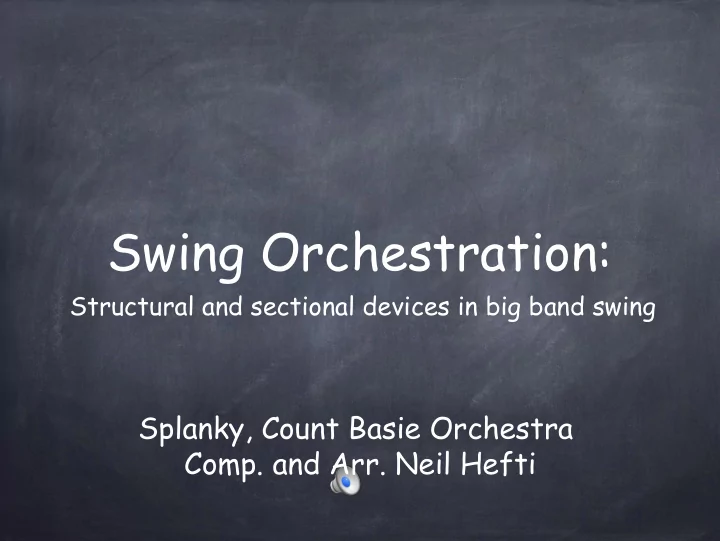

Swing Orchestration: Structural and sectional devices in big band swing Splanky, Count Basie Orchestra Comp. and Arr. Neil Hefti
What is orchestration? Orchestration refers to the assignment of instruments to the various required elements of music in order to create a specific distribution of sound. In order for a piece of music to be recognizable it contains 3 main elements: Rhythm, Harmony, and Melody. Orchestration is an important part of adapting an existing musical piece to a particular ensemble. In short, orchestration refers to who plays what note, when.
How is that different from arrangement? Orchestration is an element of arrangement, but it doesn’t go as far as arrangement. Arrangement can include reharmonization, or completely redesigning a melodic/rhythmic pattern to accompany an existing set of harmonies. The most obvious instance of this in swing music is the Shout Chorus: music that is harmonically similar but melodically different from the main theme. Shiny Stockings Main Theme: Shiny Stockings Shout Chorus
What is call-and- response? Call and response is a musical device used extensively in western musical forms. The principal is as straightforward as it sounds. Some number of musicians make a musical statement, and some number of musicians make a different musical statement in response. In the swing idiom, call and response is typically between one section and another. The sections are Reeds Brass Trumpets Trombones Rhythm (Piano, Bass, Guitar, Drums)
Solo Section backgrounds One typical element of orchestration is what section plays the background figures behind a soloist. The most typical way to orchestrate this is to have reeds playing backgrounds behind a brass soloist, or brass playing behind a reed soloist. Another way is to have the low pitched instruments playing behind the solo.
Physical Positioning as an orchestration device The use of physical space was an element of orchestration in the swing era. Bands such as the Ellington orchestra (right) would be seated in sections away from each other flat or in a V formation to give stereo effects to the call and response.
Solo Section Trading It was very common in the swing era for one soloist to solo over the main theme, and a different soloist to play the bridge, then hand back the solo to the original soloist when the main theme returns Good Queen Bess Alto Saxophone A, A Muted Trumpet B Alto Saxophone A
Elements Recap Trading figures between reeds and brass in the melody sections. Passing the solo off to another instrument at the bridge (i.e. B section of AABA forms). Backgrounds usually from other section during solos.
Stompin’ at the Savoy Edgar Sampson, Chick Webb, Benny Goodman 1936 Performed by the Benny Goodman Orchestra Which Elements does it feature?
Main Stem Edward “Duke” Ellington, 1944 Performed by the Duke Ellington Orchestra Which Elements does it feature?
Tickle Toe Lester Young, 1945 Performed by the Count Basie Orchestra Which Elements does it feature?
Recommend
More recommend